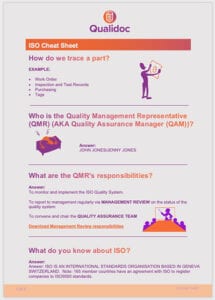According to recent information which has come my way, prime contractors (OEMs) and standards boards are becoming increasingly concerned about the insufficient depth of AS90XX audit reports, which they are returning to certification boards as unacceptable.
Three examples of immediate concern, especially to the aerospace industry, are:
- DOCUMENT CONTROL (no surprise there) ESPECIALLY CONFIGURATION MANAGEMENT
- PROCUREMENT (PURCHASING and SUPPLIER CONTROL)
- PRODUCT ACCEPTANCE SOFTWARE
Thirteen ANAB NCRs have been recorded against the above in the past three years, primarily in configuration management; some of these were repeat NCRs. This is in addition to the complaints about “insufficient root cause analysis*. As a result, Configuration Management will move to AS9100, Clause 7.1 (Planning of product realization) in the next revision.
As another consequence of this weakness, OEMs are contacting standards boards directly about unsatisfactory audits rather than the certification bodies involved. They have also started conducting their own validation audits with AS91XX suppliers.The irony of this does not escape me, given that prime contractors were at pains some years ago to replace their audits of suppliers with acceptance of certification to international quality management standards such as AS9100 and ISO9001. I remember visiting a company in Ontario expecting to do a day’s work on the quality system, only to find six prime contractors’ supply auditors unexpectedly on site and my client in a panic.
For years I have been bleating about the presence of “dodgy assessors” in the quality system assessment market. I am not saying these organisations are responsible for the concerns noted above, but the fact that non-certified assessors have been allowed into the market for many years will not have helped the situation. I have rescued companies that have paid £400 or some similar sum for a so-called “quality manual” which purports to cover their quality system requirements, and a “certificate”. They had no description of management responsibility and authority, let alone that of processes and well-expressed documentation which connect and give stability to the business and confidence to employees.
It is not just the money and the lack of respect for the standards; it is the embarrassment of people who are sometimes highly qualified in their field but don’t understand the commitment required to implement and maintain a quality system that is a worthwhile investment. Unfortunately the awful truth dawns when they are refused entry to prime contractors’ Approved Suppliers Lists. Prime contractors will not even consider an application if the company is not certified by a recognised international standards board such as ANAB, SCC and UKAS. All these standards boards carry lists of approved certification bodies.
Document preparation and control has been a major weakness and cause of failure in certification audits for as long as I have been in quality management consulting. Poorly-written documentation has a dire effect on the integrity of a quality system. It also affects the choice of measurements, bearing in mind the current enthusiasm for measurement and analysis. As a voice in the wilderness, I maintain that measurement of anything in a quality system is pointless unless the objectives and parameters for that measurement are clearly expressed first of all in words. We have to trust the narrative and the judgement of qualified people; that’s why they were hired in the first place.
As Sir Francis Bacon observed: “writing maketh an exact man”.

Recent Comment